- This is PANASIA
- ESG Management
- History
- Smart PANASIA
- Contact information
 About
About
Check PANASIA introduction,
ESG management, and History
information
- Energy Solutions
- Air Solutions
- Water Solutions
 Eco-friendly Solution
Eco-friendly Solution
About Global environmental
regulation, Hydrogen business,
Air quality, and Water quality
environment solutions
- Product Service
- Service Network
- Customer Service
 Customer Support
Customer Support
Check the Panasia’s
after service
- About
- Eco-friendly Solution
- Customer Support
- Media
NEWS

COVID Safe Zone, factories filled with scrubbers
2nd factory produces non-stop day and night
Maximized
efficiency with smart factory selected as pilot program
On
August 27, Typhoon Bavi swept through Korea. The Panasia Busan plant was packed
with scrubbers (ship desulfurization equipment) in production. Although the
shipbuilding industry is said to be in a state of economic recession, this is
not the case for employees of Panasia. This is largely thanks to a considerable
number of owners of both new and existing ships ordering large volumes of
Panasia scrubbers to avoid being subject to the International Maritime
Organization (IMO) regulations.
Panasia
is maximizing efficiency with IT technology and its smart factory system. In
particular, the process is carried out by checking the progress of the company
in real time. Thanks to this, we are meeting 100% of delivery times in the face
of massive volumes of orders.
◇ Newly built 2nd factory this year is also packed with scrubbers
The Panasia headquarters located in Mieumsandan 3-ro, Gangseo-gu, Busan, have already boasted the scale of a medium-sized company, not a small-sized company. Completed in December 2014, the building area is 17,115㎡ and the total floor area is 35,606㎡. From core equipment and parts production to R&D and customer management, everything is done right here.
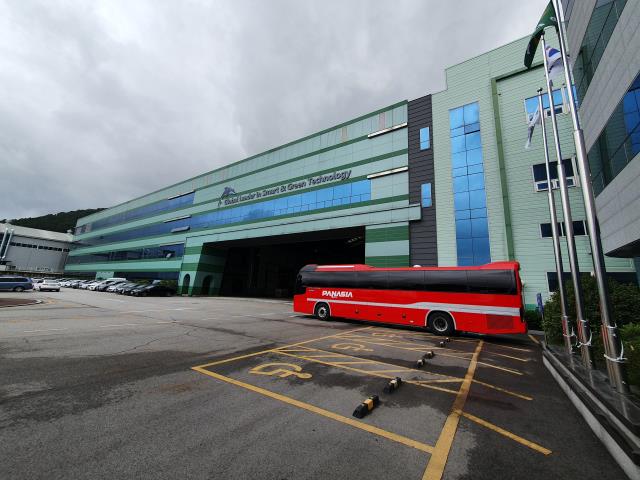
View of Panasia HQ and Factory 1
Panasia completed its 2nd factory in June as it was not enough to have one factory. The second factory also has a building area of 9837㎡ (total area of 15,504㎡). The second factory also has a full range of scrubber bodies and internal parts that are being produced. The scrubber is a device that reacts and removes sulfur oxides contained in exhaust gas generated from ship engines and boilers with seawater.
The scrubber we have on site is about three times the height of an adult and is the smallest model manufactured. Larger size equipment tends to be as big as small buildings. They tend to be more difficult to move and are produced and installed directly at shipyards with ships. The price is over 1 billion won for smaller ones and 5 billion won for the larger parts. Panasia produced 260 scrubbers last year alone due to a runaway order. Compared to 2018 (20), it increased by 240. This is the backstory to the sales from 57.2 billion won in 2018 to 3.284 trillion won last year.
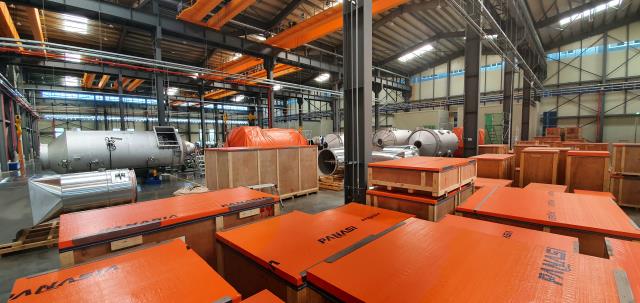
Scrubbers and related parts that filled Factory 2 at Panasia
The reason Panasia is busy even in the midst of COVID-19 is due to orders that are piling up enough to have to be produced for the next 1-2 years. As of the end of 1H, the scrubber order backlog is 49.5 billion won. The scrubber takes a total of 8 months to produce the finished product and 11 to 12 months to deliver, which is recognized as sales.
◇100% delivery in case of order congestion and MES system is the secret to success
It is said that Panasia has experienced severe competition from other companies due to a surge in orders. Panasia told the shipowners that it would not be able to meet the delivery date and ended up producing defective goods because it could not handle the sheer volume of orders. However, from last year to the present, Panasia has never failed to meet a delivery date. Rather, competitors have been unable to meet their respective delivery deadlines due to the aftermath of COVID-19.
One of the secret recipes for Panasia’s success lies in the MES system (manufacturing execution system) that computerizes the entire process. MES systems with human-sized monitors are installed throughout the factory. It displays all processing details from production to delivery, such as scrubber cutting, bending, acid treatment, insulation, assembly, and shipowner inspection in real time.
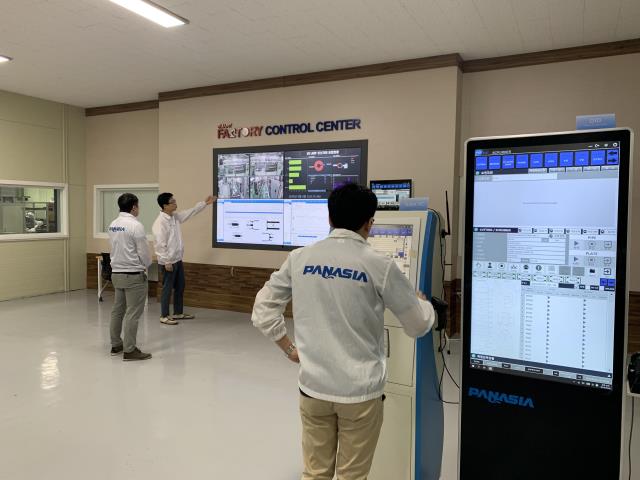
Panasia MES system (manufacturing execution system)
PANASIA engineers and employees of more than 80 partner companies all start and finish work by stamping barcodes on the MES system. This makes it possible to quickly recognize and respond to possible problems in each process. Reducing the defect rate and maximizing the production speed—this is the system designed independently by PANASIA.
An official from PANASIA said, “In the past, if there was a delay in the process, we notified and resolved it through phone or e-mail to the partner company. “At present, all participants can recognize and respond to problems in real time,” he said. “Thanks to this, there has not been a single delivery delay even with an increase in orders since last year.”
◇ Produced core parts in smart factory and selected as a government pilot program
UV lamp performance directly affects the IMO regulations for ships. Ballast water means seawater to balance the ship. When there is no load, the ship floats up and the balance becomes unstable, so it is balanced by drawing seawater from the sea. Conversely, when loading luggage, seawater must be discharged again.
When seawater is discharged, environmental pollution occurs. This is because microorganisms grow in the seawater inside the ship and disturb the ecosystem of the discharge area. The ballast water treatment System plays a role of removing microorganisms, and a UV lamp facilitates that process. Consistent quality is important for this, and Panasia has secured this with the establishment of its first smart factory.
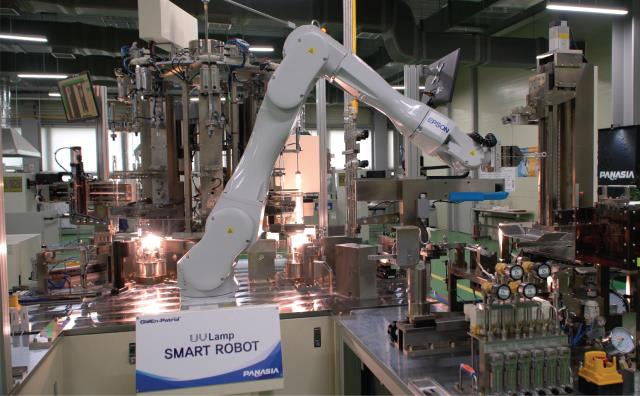
Panasia Smart Factory
UV lamp performance directly affects the IMO regulations for ships. Ballast water means seawater to balance the ship. When there is no load, the ship floats up and the balance becomes unstable, so it is balanced by drawing seawater from the sea. Conversely, when loading luggage, seawater must be discharged again.
When seawater is discharged, environmental pollution occurs. This is because microorganisms grow in the seawater inside the ship and disturb the ecosystem of the discharge area. The ballast water treatment System plays a role of removing microorganisms, and a UV lamp facilitates that process. Consistent quality is important for this, and Panasia has secured this with the establishment of its first smart factory.
“In the past, people made UV lamps themselves, so the defect rate was high and there was a lot of variation in performance by product,” said a Panasia official. “We have secured not only quality, but also cost reduction and mass production effect,” he added.
This is a factor that differentiates Panasia from its competitors. This is because, if core parts have been procured from other countries, it may be difficult to secure them due to COVID-19. This is often the cause for not being able to meet the delivery deadline. A previous official said, “After COVID-19, our competitors are falling one by one,” and “It is also important to be able to procure core parts by self-sufficiently.”
◇ ICT-friendly equipment is also remotely managed with satellite control system
The headquarters was also equipped with a satellite control system (MSCS) suitable for the fourth industry and the untact era. It is one of the core competitiveness of Panasia. The scrubbers supplied by Panasia are located in waters and shipyards around the world.
Panasia is equipped with a communication system on the scrubber and remotely managed by MSCS. It diagnoses scrubber failure via satellite and provides solutions. This is a service that has a profound impact on customers. This is because if the scrubber breaks down, in the worst case, the voyage has to be stopped and significant losses can result.
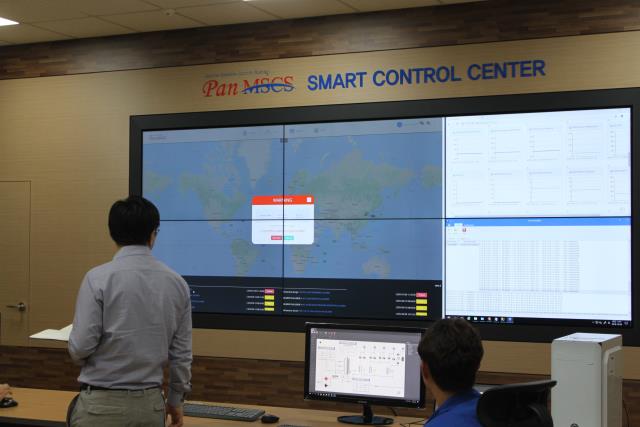
Panasia satellite control system
A previous official said, “We are checking in real time for signals that are likely to signify a problem with MSCS. If a problem occurs, we provide a solution to arrange experts and related parts in the port where the vessel is moored.” He added, “MSCS is a technology that started before large competitors,” and added, “Because of such a system, we’re constantly getting more orders.”
Panasia plans to have a system similar to that of MSCS in the hydrogen extractor business, which is being promoted as a new enterprise. In January of last year, the government unveiled the “Hydrogen Economy Revitalization Roadmap,” which will see the installation of 1,200 charging stations for hydrogen vehicles nationwide by 2040. The hydrogen extractor is a device that extracts high-purity hydrogen from natural gas such as LNG through reforming and is required for charging stations.










